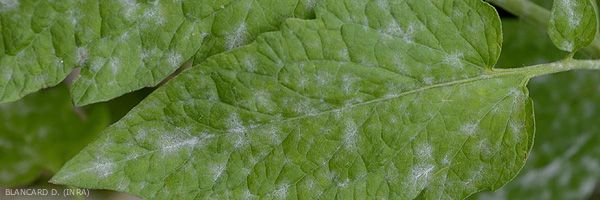
Pseudoidium neolycopersici (L. Kiss) L. Kiss
External powdery mildew
- classification : Fungi, Ascomycota, Leotiomycetes, Leotiomycetidae, Erysiphales, Erysiphaceae
- téléomorphe : Erysiphe
-synonyme : Oidium neolycopersici L. Kiss, (2001)
- English name: powdery mildew, white mold
This new tomato powdery mildew , very different from Leveillula taurica , has been talking about it for two decades in many countries around the world , in Europe, Africa, north and south of the American continent, and in Asia. In Europe, it would have appeared chronologically at the beginning of the 1980s in the Netherlands, Great Britain (1987), Belgium, Switzerland (1987), Germany (1987-1988), Czechoslovakia (1988), Italy (1989) and would have spread towards the Mediterranean basin, in Crete (1990). It would have established itself later in the United States and Canada during the 1990s and under unknown methods.
This powdery mildew, which has the unfortunate tendency to spread rapidly in new affected production areas, or even in countries where it is emerging, can cause considerable damage if no measures are taken to control it. It is found both under shelters and in the open field.
It was introduced in France in 1986 in the Orleans region through young tomato plants imported from the Netherlands. Subsequently, it spread to all production areas, attacking under cover tomato crops almost all year round.
It is now feared by greenhouse growers who are often obliged to implement intensive preventive chemical control at certain times of the year.
The identification of Pseudoidium neolycopersici , the sexual form of which has never been observed, has given rise to much confusion in the past. Thus, several other names could be attributed to it erroneously: Erysiphe orontii Cast., Erysiphe polygoni DC, Erysiphe cichoracearum DC, possibly Oidium lycopersicum Cooke & Massee Emend. Noordeloos. Studies, particularly on samples from several herbaria, have shown that in many cases we already have to do with Oidium neolycopersici (subgenus Pseudoidium ). This fungus is therefore not that recent; for example, its presence in Asia dates back at least fifty years.
It should be noted that a different powdery mildew species is particularly prevalent in Australia; this is Oidium lycopersici Cooke & Massee, Grevillea (subgenus reticuloidium ). The symptoms it causes on tomatoes are quite comparable to those due to P. neolycopersici . This species has been present in this country since 1888. It is said to be close to O. longipes Noordel. & Loer. affecting eggplant, but also Cyphomandra sp., tobacco and petunia.
The situation of powdery mildew species infested with tomato in the world is probably not yet definitively clarified if one already refers to the differences in pathogenicity reported for P. neolycopersici , whether in terms of host spectrum or virulence. Moreover, a recent work carried out in Australia made it possible to highlight on tomato a species suspected of being Golovinomyces biocellatus (Ehrenb.) VP Heluta (1988), previously known mainly on Lamiaceae.





